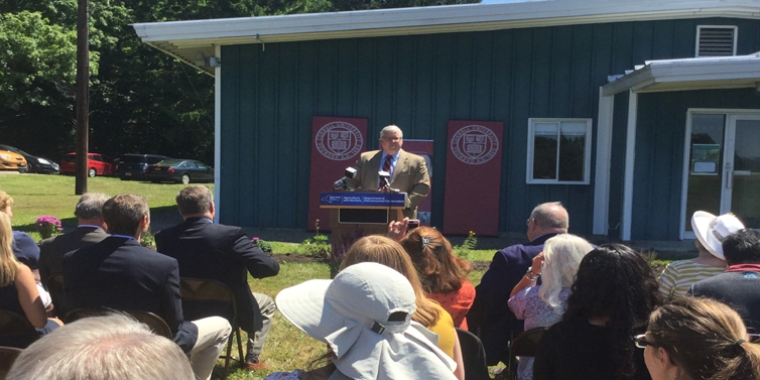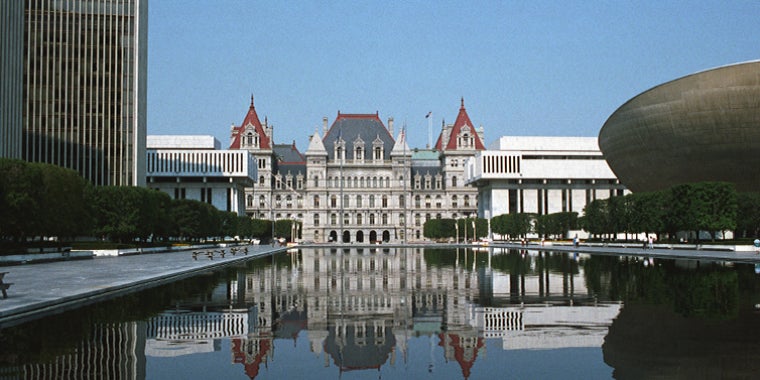O'Mara joins Cornell University leaders, Cuomo administration officials, others to unveil initial recommendations of the NYS Pollinator Task Force ~ Press conference held at Cornell University earlier today ~ Read more, including a copy of the full plan
June 24, 2016
-
ISSUE:
- agriculture economy
-
COMMITTEE:
- Environmental Conservation

Ithaca, N.Y., June 24—State Senator Tom O’Mara (R,C,I-Big Flats), chairman of the Senate Environmental Conservation Committee, today joined top Cuomo administration officials, representatives and researchers from the Cornell University College of Agriculture and Life Sciences (CALS), and other stakeholders to announce the first set of recommendations from the New York State Pollinator Task Force.
The announcement was made at Cornell University’s Dyce Lab this morning. In addition to CALS Dean Kathryn J. Boor, today's news conference also featured state Agriculture Commissioner Richard Ball, state Department of Environmental Conservation (DEC) Executive Deputy Commissioner Kenneth Lynch, Ron Rausch, Director of the Environmental Management Bureau at the state Office of Parks, Recreation and Historic Preservation (OPRHP), and Assemblywoman Barbara Lifton (D-Ithaca).
O’Mara, who also serves on the Senate Agriculture Committee, said, “The oversight, protection and recovery of native and managed honeybee and other native pollinator populations are critically important to the future strength and resiliency of so many of our farmers and producers, as well as to the agricultural industry overall in New York and states across the nation. I’m hopeful that these recommendations and continuing work with key stakeholders will assist the state’s ongoing leadership and facilitate action in developing and implementing an effective and successful long-term Pollinator Protection Plan and other health strategies. It’s a critical agricultural, environmental and economic challenge.”
Kathryn J. Boor, the Ronald P. Lynch Dean of the College of Agriculture and Life Sciences said, “Pollinators are oftentimes the unsung heroes of agriculture and food security, but without them many of New York’s most high value fruits would never see successful production. Cornell University couldn’t be more proud of the work done by our scientists and extension personnel on this report, and we look forward to continuing partnerships with the New York State Department of Agriculture and Markets, the New York State Department of Environmental Conservation, and the New York State Office of Parks, Recreation and Historic Preservation in order to ensure that the Empire State’s pollinators remain robust contributors to environmental and economic well-being.”
Pollinators contribute substantially to the state’s economy. According to the U.S. Department of Agriculture, pollinators provide approximately $344 million worth of pollination services to New York and add $29 billion in value to crop production nationally each year. New York’s ability to produce crops such as apples, grapes, cherries, onions, pumpkins and cauliflower relies heavily on the presence of pollinators.
In April 2015, Governor Andrew Cuomo established the interagency task force, led by the state departments of Agriculture and Markets (Ag and Markets) and Environmental Conservation, to begin producing the plan as well as examine other issues critical to the sustained well-being of the state’s pollinator populations.
The recommendations announced today focus on:
> the development of voluntary Best Management Practices (BMPs) for all pollinator stakeholders, including beekeepers, growers, land owners, state agencies and the general public;
> habitat enhancement efforts to protect and revive populations of native and managed pollinators;
> research and monitoring of pollinators to better understand, prevent and recover from pollinator losses; and
> development of an outreach and public education program on the importance of pollinators, engaging the public to be active participants to seek solutions to pollinator declines.
The 2016-17 state budget includes $500,000 through the Environmental Protection Fund (EPF) for the plan’s implementation. The recommendations released today detail that funds will be used to conduct additional research on the impacts of pesticide and pathogens/parasite interactions on native and managed pollinator health, as well as the affects of bee-husbandry practices on the performance of managed hives. Pollinator research funding will also support a multi-year evaluation conducted by DEC on the status and distribution of New York State’s native pollinator species. EPF funding will also support implementation of BMPs and outreach and education activities, including the creation of pollinator gardens and interpretative signage at select State Park locations, and the establishment of the New York’s Tech Team for Beekeepers, which will provide participating apiaries with site-specific technical support.
Although honey production in New York State was up 9% last year, New York’s beekeepers continue to experience over-winter colony loss at unsustainable levels. Recent research indicates that the loss of managed pollinator colonies in the State over the past four years has exceeded 50% while some commercial migratory pollinators have seen colony losses in excess of 70%. This is compounded by the losses in the native pollinator community and the habitat that sustains them. Trends suggest that pollinator population loss are a result of several interacting environmental stressors, including: parasites/pathogens; pesticide exposure; nutrient deficiencies; climate change; habitat loss and fragmentation; poor management practices; and lack of genetic diversity.
As a result, the Task Force emphasized in its report the need for comprehensive, state-focused research to better understand the status of native pollinators in the State and the factors that impact both managed and wild pollinator health and performance.
In May, O’Mara hosted a forum in Albany featuring experts from CALS on strategies to protect the state’s honeybee and native pollinator populations.
The “Honeybees & Native Pollinators Roundtable" offered beekeepers, researchers, government officials and farm, environmental and agricultural business groups the opportunity to highlight points for inclusion in the development of a New York State Pollinator Protection Plan.
At the time, O’Mara said he hoped the event would assist and spur action on the development and implementation of New York’s Pollinator Protection Plan.
In addition to CALS researchers and scientists, participants at the May 24th round table discussion included representatives of the governor’s office, and the state Departments of Agriculture and Markets and Environmental Conservation ; regional beekeepers and beekeeper associations, including the Southern Adirondack Beekeepers and Rulison Honey Farms LLC (Amsterdam); New York Farm Bureau; The Nature Conservancy of New York; the National Resources Defense Council (NRDC); and Citizens Campaign for the Environment.
The state’s agricultural industry is heavily dependent upon the health of honeybees, in particular, which annually pollinate nearly half a billion dollars’ worth of farm crops. Additionally, during the state’s colder months, New York’s migratory beekeepers travel around the country to help pollinate crops that grow in year-round climates.
Read today's full announcement HERE. Review a copy of the "New York State Pollinator Protection Plan" HERE (a copy is also attached above).
Read the advisory on this morning's news conference, which began at 11:00 a.m., HERE.



